Analysis of the Potential for Gas Micro-Cogeneration Development in Poland Using the Monte Carlo Method
Abstract
1. Introduction
2. Data for Analysis
2.1. Literature Data Presenting the Demand for Electricity and Heat for Households
2.2. Energy Demand for the Selected Building
3. Methods and Assumptions
- Access to the gas network and district heating is described by binomial distribution. It was assumed that the assembly of mCHP is possible only in the case of objects that are connected to the gas network (55.74% of the population of single-family houses in Poland). Access to the gas network in each voivodeship is described by a different binomial distribution built based on the data presented in Table 2. At the same time, it was assumed that in the case of buildings connected to the municipal heating network (40.11% of the population of single-family houses in Poland), the assembly of mCHP is not justified.
- Two daily electricity demand profiles (Figure 8) at an hourly interval: one for weekdays and the other for non-working days (weekends and holidays). It was assumed that the ratio of working days to non-working days is 5:2.
- The annual heat demand for hot water preparation (kWh/year) was calculated as the product of the annual heat demand for DHW preparation per person (kWh/year/person) and the number of people in the household. Annual heat demand for DHW preparation per person is described by a rectangular (uniform) probability density distribution with a minimum value of 900 kWh/year/person and a maximum value of 1100 kWh/year/person. The number of persons in a household was modeled by discrete polynomial probability distributions (prepared based on data in Table 3 and Table 4) describing the structure of households in terms of the number of persons. The drawn values of people in the household were used to calculate the demand for heat for the preparation of domestic hot water in a hypothetical household. It is assumed that the distribution of domestic hot water is uniform throughout the year. The annual demand for heating a single-family house was calculated as the ratio of the individual heating demand (kWh/(m2·year)) and the area of household (m2). The individual heating demand was described by the Weibull distribution with the parameters of location = 0, scale = 140.24 and shape = 1.456. The distribution was prepared based on data published by the Central Statistical Office (CSO) [1] and concerning the individual demand for natural gas for household heating (kWh/(m2·year)). The structure of the single-family houses area in Poland was described by a continuous probability distribution prepared on the basis of data (Table 4) published by the portal Oferteo [64] and CSO data from the census carried out in 2011 [65].
- The annual heat demand for heating household was divided into individual months of the year based on the number of heating degree days in individual months [66].
- The number of degree days for individual months depends on the geographical location of the building. Poland was divided into 16 geographical locations. The division was consistent with the administrative division into voivodeships (the highest-level administrative subdivision of Poland). Degree days of heating were presented for the capital of each voivodeship on Figure 4. The location of the building was assigned in the process of drawing from the probability density distribution prepared based on the population of people living in individual Polish voivodeships. The source of the data have was CSO [67].
- Euro price was 4.5 PLN (polish zloty);
- The share of households living in multi-family buildings in the total number of households was 55.3%, while in single-family housed in terraced, semi-detached or detached housed was 44.7%;
- All buildings were connected to the power grid;
- The base price of gas was 0.0489 euro/kWh (GP) [1];
- The base price of electricity including transmission was 0.133 euro/kWh (EP) [1];
- The base price of gas and the base price of electricity were changed depending on the dependencies adopted in Chapter 4 (EPI, GPI). In addition, in Poland, changes in energy prices for households depend on market price fluctuations over at least six-month periods;
- The fixed distribution fee was 1.78 euros/month;
- The producer coefficient was 0.8. The possibility of using the Prosumer program was assumed [68];
- The cost of buying and installing a traditional gas-fired boiler was 1555.56 euros;
- Other costs of installing the boiler or mCHP were considered the same;
- Possible correlations between variables had not been taken into account;
- The cost of servicing a natural gas boiler was on average 22.22 euros/year;
- The costs of operating a micro-CHP boiler were on average 44.44 euros/year;
- The economic efficiency calculation was performed on a monthly basis for the entire life cycle of micro-CHP boilers and gas-fired boilers, which was the same for both technologies for 15 years;
- The micro-CHP boiler had two burners: main with nominal power equal to 5.3 kW and peak one with 20 kW;
- Operation of the peak burner was only possible with simultaneous operation of the basic burner with full nominal power;
- The electricity generator in the micro-CHP boiler had a nominal power of 1 kW;
- The actual power of the electricity generator depends on the actual power of the main burner, which depends on the heat demand at the moment;
4. Results and Discussion
4.1. Results for Analyzed Building
4.2. Effect of Model Reduction
4.3. Results for Households in Poland
5. Conclusions
Author Contributions
Funding
Conflicts of Interest
Abbreviations
| AB | Analyzed building |
| AEP | Assumed average electricity price for the next 15 years, euros/kWh |
| AGP | Assumed average natural gas price for the next 15 years, euros/kWh |
| CHP | Combined heat and power |
| CSO | Central statistical office |
| dd15 | Degree-day values, K·day/year |
| DHW | Domestic hot water |
| e | electricity |
| EP | Base price of electricity including transfer, euros/kWh |
| EPI | Electricity price index |
| G11 | Electricity price tariff in Poland |
| GHG | Greenhouse gases |
| GP | Base gas price, euros/kWh |
| GPI | Gas price index |
| ICE | Internal combustion engine |
| mCHP | Micro-combined heat and power |
| ORC | Organic Rankine cycle |
| PCM | Phase change material |
| PV/T | Solar photovoltaic hybrid technologies |
| SE | Stirling engine |
| SG100k | Selected group for 100,000 households, EPI = 1.0 and GPI = 1.0 |
| shp | Percentage share of the number of households in the voivodship in relation to the total for the whole country (Poland) |
| th | thermal |
| WD | Weekday |
| WE | Weekend day |
| WP | Whole population of households in Poland |
References
- Central Statistical Office. Energy Consumption in Households in 2018; Central Statistical Office of Poland: Warsaw, Poland, 2019.
- IoEP-NRI. Inventory of Greenhouse Gases in Poland for 1988–2017; The National Centre for Emissions Management: Warsaw, Poland, 2019. [Google Scholar]
- Green Economy Indicators in Poland 2019. Available online: https://stat.gov.pl/en/topics/environment-energy/environment/green-economy-indicators-in-poland-2019,3,3.html (accessed on 8 April 2020).
- Böckl, B.; Greiml, M.; Leitner, L.; Pichler, P.; Kriechbaum, L.; Kienberger, T. HyFloW—A hybrid load flow-modelling framework to evaluate the effects of energy storage and sector coupling on the electrical load flows. Energies 2019, 12, 956. [Google Scholar] [CrossRef]
- Teh, S.H.; Wiedmann, T.; Moore, S. Mixed-unit hybrid life cycle assessment applied to the recycling of construction materials. J. Econ. Struct. 2018, 7, 13. [Google Scholar] [CrossRef]
- Sornek, K.; Filipowicz, M.; Goryl, W.; Mokrzycki, E.; Mirowski, T.; Duraczyński, M. The analysis of the wind potential in selected locations in the southeastern Poland. E3S Web Conf. 2017, 14, 01014. [Google Scholar] [CrossRef]
- Pepermans, G.; Driesen, J.; Haeseldonckx, D.; Belmans, R.; D’haeseleer, W. Distributed generation: Definition, benefits and issues. Energy Policy 2005, 33, 787–798. [Google Scholar] [CrossRef]
- Martinez, S.; Michaux, G.; Salagnac, P.; Bouvier, J.L. Micro-combined heat and power systems (micro-CHP) based on renewable energy sources. Energy Convers. Manag. 2017, 154, 262–285. [Google Scholar] [CrossRef]
- Parliament, T.H.E.E.; Council, T.H.E.; The, O.F.; Union, E. Directive 2004/8/EC of the European Parliament and of the Council of 11 February 2004; European Parliament: Brussels, Belgium, 2004.
- Kaarsberg, T.; Fiskum, R.; Deppe, A.; Kumar, S.; Rosenfeld, A.; Romm, J. Combined heat and power for saving energy and carbon in residential buildings. Build. Ind. Trends 2000, 149, 1–13. [Google Scholar]
- Jung, Y.; Kim, J.; Lee, H. Multi-criteria evaluation of medium-sized residential building with micro-CHP system in South Korea. Energy Build. 2019, 193, 201–215. [Google Scholar] [CrossRef]
- Wajs, J.; Mikielewicz, D.; Bajor, M.; Kneba, Z. Experimental investigation of domestic micro-CHP based on the gas boiler fitted with ORC module. Arch. Thermodyn. 2016, 37, 79–93. [Google Scholar] [CrossRef]
- Taie, Z.; Hagen, C. Experimental thermodynamic first and second law analysis of a variable output 1–4.5 kWe, ICE-driven, natural-gas fueled micro-CHP generator. Energy Convers. Manag. 2019, 180, 292–301. [Google Scholar] [CrossRef]
- Thu, K.; Saha, B.B.; Chua, K.J.; Bui, T.D. Thermodynamic analysis on the part-load performance of a microturbine system for micro/mini-CHP applications. Appl. Energy 2016, 178, 600–608. [Google Scholar] [CrossRef]
- Qiu, S.; Gao, Y.; Rinker, G.; Yanaga, K. Development of an advanced free-piston Stirling engine for micro combined heating and power application. Appl. Energy 2019, 235, 987–1000. [Google Scholar] [CrossRef]
- Cardozo, E.; Erlich, C.; Malmquist, A.; Alejo, L. Integration of a wood pellet burner and a Stirling engine to produce residential heat and power. Appl. Therm. Eng. 2014, 73, 671–680. [Google Scholar] [CrossRef]
- Antonelli, M.; Francesconi, M.; Baccioli, A.; Caposciutti, G. Experimental Results of a Wankel-type Expander Fuelled by Compressed Air and Saturated Steam. Energy Procedia 2017, 105, 2929–2934. [Google Scholar] [CrossRef]
- Staffell, I. Zero carbon infinite COP heat from fuel cell CHP. Appl. Energy 2015, 147, 373–385. [Google Scholar] [CrossRef]
- Bahlawan, H.; Poganietz, W.R.; Spina, P.R.; Venturini, M. Cradle-to-gate life cycle assessment of energy systems for residential applications by accounting for scaling effects. Appl. Therm. Eng. 2020, 171, 115062. [Google Scholar] [CrossRef]
- Calise, F.; Figaj, R.D.; Vanoli, L. Energy performance of a low-cost PhotoVoltaic/Thermal (PVT) collector with and without thermal insulation. IOP Conf. Ser. Earth Environ. Sci. 2019, 214, 012116. [Google Scholar] [CrossRef]
- Algieri, A.; Morrone, P. Energetic analysis of biomass-fired ORC systems for micro-scale combined heat and power (CHP) generation. A possible application to the Italian residential sector. Appl. Therm. Eng. 2014, 71, 751–759. [Google Scholar] [CrossRef]
- Kharseh, M.; Al-Khawaja, M.; Hassani, F. Optimal utilization of geothermal heat from abandoned oil wells for power generation. Appl. Therm. Eng. 2019, 153, 536–542. [Google Scholar] [CrossRef]
- Cioccolanti, L.; Tascioni, R.; Arteconi, A. Simulation analysis of an innovative micro-solar 2kWe Organic Rankine Cycle plant for residential applications. Energy Procedia 2017, 142, 1629–1634. [Google Scholar] [CrossRef]
- Obi, J.B. State of art on ORC applications for waste heat recovery and micro-cogeneration for installations up to 100kWe. Energy Procedia 2015, 82, 994–1001. [Google Scholar] [CrossRef][Green Version]
- Linke, P.; Papadopoulos, A.I.; Seferlis, P. Systematic methods for working fluid selection and the design, integration and control of organic Rankine cycles—A review. Energies 2015, 8, 4755–4801. [Google Scholar] [CrossRef]
- Zheng, C.Y.; Wu, J.Y.; Zhai, X.Q.; Yang, G.; Wang, R.Z. Experimental and modeling investigation of an ICE (internal combustion engine) based micro-cogeneration device considering overheat protection controls. Energy 2016, 101, 447–461. [Google Scholar] [CrossRef]
- Moriconi, N.; Laranci, P.; D’Amico, M.; Bartocci, P.; D’Alessandro, B.; Cinti, G.; Baldinelli, A.; Discepoli, G.; Bidini, G.; Desideri, U.; et al. Design and preliminary operation of a gasification plant for micro-CHP with internal combustion engine and SOFC. Energy Procedia 2015, 81, 298–308. [Google Scholar] [CrossRef]
- De Santoli, L.; Lo Basso, G.; Albo, A.; Bruschi, D.; Nastasi, B. Single cylinder internal combustion engine fuelled with H2NG operating as micro-CHP for residential use: Preliminary experimental analysis on energy performances and numerical simulations for LCOE assessment. Energy Procedia 2015, 81, 1077–1089. [Google Scholar] [CrossRef]
- Pilavachi, P.A. Mini- and micro-gas turbines for combined heat and power. Appl. Therm. Eng. 2002, 22, 2003–2014. [Google Scholar] [CrossRef]
- Harrison, J.; On, E. Stirling engine systems for small and micro combined heat and power (CHP) applications. In Small and Micro Combined Heat and Power (CHP) Systems: Advanced Design, Performance, Materials and Applications; Woodhead Publishing: Witney, UK, 2011; pp. 179–205. ISBN 9781845697952. [Google Scholar]
- Scarpete, D.; Uzuneanu, K.; Badea, N. Stirling engine in residential systems based on renewable energy. In Proceedings of the 4th WSEAS International Conference on Energy Planning, Energy Saving, Environmental Education, EPESE’10, 4th WSEAS International Conference on Renewable Energy Sources, RES ’10, Kantaoui, Sousse, Tunisia, 3 May 2010; pp. 124–129. [Google Scholar]
- Moghadam, R.S.; Sayyaadi, H.; Hosseinzade, H. Sizing a solar dish Stirling micro-CHP system for residential application in diverse climatic conditions based on 3E analysis. Energy Convers. Manag. 2013, 75, 348–365. [Google Scholar] [CrossRef]
- Hawkes, A.; Staffell, I.; Brett, D.; Brandon, N. Fuel cells for micro-combined heat and power generation. Energy Environ. Sci. 2009, 2, 729–744. [Google Scholar] [CrossRef]
- Barbieri, E.S.; Spina, P.R.; Venturini, M. Analysis of innovative micro-CHP systems to meet household energy demands. Appl. Energy 2012, 97, 723–733. [Google Scholar] [CrossRef]
- Arteconi, A.; Del Zotto, L.; Tascioni, R.; Cioccolanti, L. Modelling system integration of a micro solar Organic Rankine Cycle plant into a residential building. Appl. Energy 2019, 251, 113408. [Google Scholar] [CrossRef]
- Bianchi, M.; De Pascale, A.; Spina, P.R. Guidelines for residential micro-CHP systems design. Appl. Energy 2012, 97, 673–685. [Google Scholar] [CrossRef]
- Ito, H. Economic and environmental assessment of residential micro combined heat and power system application in Japan. Int. J. Hydrog. Energy 2016, 41, 15111–15123. [Google Scholar] [CrossRef]
- Streimikiene, D.; Baležentis, T. Multi-criteria assessment of small scale CHP technologies in buildings. Renew. Sustain. Energy Rev. 2013, 26, 183–189. [Google Scholar] [CrossRef]
- Ren, H.; Gao, W. Economic and environmental evaluation of micro CHP systems with different operating modes for residential buildings in Japan. Energy Build. 2010, 42, 853–861. [Google Scholar] [CrossRef]
- Lee, H.; Bush, J.; Hwang, Y.; Radermacher, R. Modeling of micro-CHP (combined heat and power) unit and evaluation of system performance in building application in United States. Energy 2013, 58, 364–375. [Google Scholar] [CrossRef]
- Entchev, E.; Gusdorf, J.; Swinton, M.; Bell, M.; Szadkowski, F.; Kalbfleisch, W.; Marchand, R. Micro-generation technology assessment for housing technology. Energy Build. 2004, 36, 925–931. [Google Scholar] [CrossRef]
- Romero Rodríguez, L.; Salmerón Lissén, J.M.; Sánchez Ramos, J.; Rodríguez Jara, E.Á.; Álvarez Domínguez, S. Analysis of the economic feasibility and reduction of a building’s energy consumption and emissions when integrating hybrid solar thermal/PV/micro-CHP systems. Appl. Energy 2016, 165, 828–838. [Google Scholar] [CrossRef]
- Kim, J.; Cho, W.; Lee, K.S. Optimum generation capacities of micro combined heat and power systems in apartment complexes with varying numbers of apartment units. Energy 2010, 35, 5121–5131. [Google Scholar] [CrossRef]
- Spitalny, L.; Myrzik, J.M.A.; Mehlhorn, T. Estimation of the economic addressable market of micro-CHP and heat pumps based on the status of the residential building sector in Germany. Appl. Therm. Eng. 2014, 71, 838–846. [Google Scholar] [CrossRef]
- Caliano, M.; Bianco, N.; Graditi, G.; Mongibello, L. Economic optimization of a residential micro-CHP system considering different operation strategies. Appl. Therm. Eng. 2016, 101, 592–600. [Google Scholar] [CrossRef]
- Dentice d’Accadia, M.; Sasso, M.; Sibilio, S.; Vanoli, L. Micro-combined heat and power in residential and light commercial applications. Appl. Therm. Eng. 2003, 23, 1247–1259. [Google Scholar] [CrossRef]
- De Paepe, M.; D’Herdt, P.; Mertens, D. Micro-CHP systems for residential applications. Energy Convers. Manag. 2006, 47, 3435–3446. [Google Scholar] [CrossRef]
- Hawkes, A.D.; Leach, M.A. Cost-effective operating strategy for residential micro-combined heat and power. Energy 2007, 32, 711–723. [Google Scholar] [CrossRef]
- Orzechowska, M.; Kryzia, D. Estimation of the future demand for natural gas in road transport in Poland. In Proceedings of the 5th International Youth Conference on Energy (IYCE), Pisa, Italy, 27–30 May 2015; pp. 1–5. [Google Scholar]
- Kryzia, D.; Pepłowska, M. The impact of measures aimed at reducing low-stack emission in Poland on the energy efficiency and household emission of pollutants. Polityka Energetyczna—Energy Policy J. 2019, 22, 121–132. [Google Scholar] [CrossRef]
- Jeleński, T.; Dendys, M.; Tomaszewska, B.; Pająk, L. The Potential of RES in the Reduction of Air Pollution: The SWOT Analysis of Smart Energy Management Solutions for Krakow Functional Area (KrOF). Energies 2020, 13, 1754. [Google Scholar] [CrossRef]
- Momen, M.; Shirinbakhsh, M.; Baniassadi, A.; Behbahani-Nia, A. Application of Monte Carlo method in economic optimization of cogeneration systems - Case study of the CGAM system. Appl. Therm. Eng. 2016, 104, 34–41. [Google Scholar] [CrossRef]
- Westner, G.; Madlener, R. The benefit of regional diversification of cogeneration investments in Europe: A mean-variance portfolio analysis. Energy Policy 2010, 38, 7911–7920. [Google Scholar] [CrossRef]
- Carpaneto, E.; Chicco, G.; Mancarella, P.; Russo, A. Cogeneration planning under uncertainty. Part I: Multiple time frame approach. Appl. Energy 2011, 88, 1059–1067. [Google Scholar] [CrossRef]
- Siler-Evans, K.; Morgan, M.G.; Azevedo, I.L. Distributed cogeneration for commercial buildings: Can we make the economics work? Energy Policy 2012, 42, 580–590. [Google Scholar] [CrossRef]
- Marquez, A.C.; Heguedas, A.S.; Iung, B. Monte Carlo-based assessment of system availability. A case study for cogeneration plants. Reliab. Eng. Syst. Saf. 2005, 88, 273–289. [Google Scholar] [CrossRef]
- McLoughlin, F.; Duffy, A.; Conlon, M. A clustering approach to domestic electricity load profile characterisation using smart metering data. Appl. Energy 2015, 141, 190–199. [Google Scholar] [CrossRef]
- Foteinaki, K.; Li, R.; Rode, C.; Andersen, R.K. Modelling household electricity load profiles based on Danish time-use survey data. Energy Build. 2019, 202, 109355. [Google Scholar] [CrossRef]
- Ramírez-Mendiola, J.L.; Grünewald, P.; Eyre, N. The diversity of residential electricity demand—A comparative analysis of metered and simulated data. Energy Build. 2017, 151, 121–131. [Google Scholar] [CrossRef]
- Nafkha, R.; Woźniakowski, T. Households Electricity Usage Analysis and the Effectiveness of Changing Tariff Group. Inf. Syst. Manag. 2018, 7, 171–179. [Google Scholar] [CrossRef]
- Mirowski, T.; Pepłowska, M. Simulation Analysis of Electricity Consumption for the Final Consumer with the Use of Smart Metering. Energy Policy J. 2016, 2, 81–91. [Google Scholar]
- Olczak, P.; Zabagło, J.; Kandefer, S.; Dziedzic, J. Influence of Solar Installation with Flat-Plate Collectors in a Detached House on Pollutants Emission and Waste Stream. In Between Evolution and Revolution—In Search of an Energy Strategy; WAT: Poznań, Poland, 2015; pp. 739–752. [Google Scholar]
- Viessmann VITOTWIN 350-F VITOTWIN 300-W. Available online: http://www.viessmann.pl/content/dam/vi-brands/PL/PDF/KP/Kogeneracja/KP-Vitotwin_350-F_i_300-W_2015_08.pdf/_jcr_content/renditions/original.media_file.download_attachment.file/KP-Vitotwin_350-F_i_300-W_2015_08.pdf (accessed on 20 April 2020).
- Alebank.pl House Construction Report: How Large is the Average Single-Family Home? Available online: https://alebank.pl/raport-o-budowie-domow-jaka-powierzchnie-ma-przecietna-nieruchomosc/ (accessed on 8 April 2020).
- Central Statistical Office. National Census; Central Statistical Office of Poland: Warsaw, Poland, 2014.
- Ministry of Development Typical Reference Year. Available online: https://www.gov.pl/web/fundusze-regiony/dane-do-obliczen-energetycznych-budynkow (accessed on 18 December 2019).
- Central Statistical Office Area and Population in the Territorial Proöle in 2019. Available online: https://stat.gov.pl/obszary-tematyczne/ludnosc/ludnosc/powierzchnia-i-ludnosc-w-przekroju-terytorialnym-w-2019-roku,7,16.html (accessed on 8 April 2020).
- Kuchmacz, J.; Mika, Ł. Description of development of prosumer energy sector in Poland. Polityka Energetyczna 2018, 21, 5–20. [Google Scholar] [CrossRef]
- Central Statistical Office. Municipal Infrastructure in 2016; Central Statistical Office of Poland: Warsaw, Poland, 2017.
- Mavrotas, G.; Florios, K.; Vlachou, D. Energy planning of a hospital using Mathematical Programming and Monte Carlo simulation for dealing with uncertainty in the economic parameters. Energy Convers. Manag. 2010, 51, 722–731. [Google Scholar] [CrossRef]
- Mirowski, T.; Sornek, K. Potential of prosumer power engineering in Poland by example of micro PV installation in private construction. Energy Policy J. 2015, 18, 73–84. [Google Scholar]
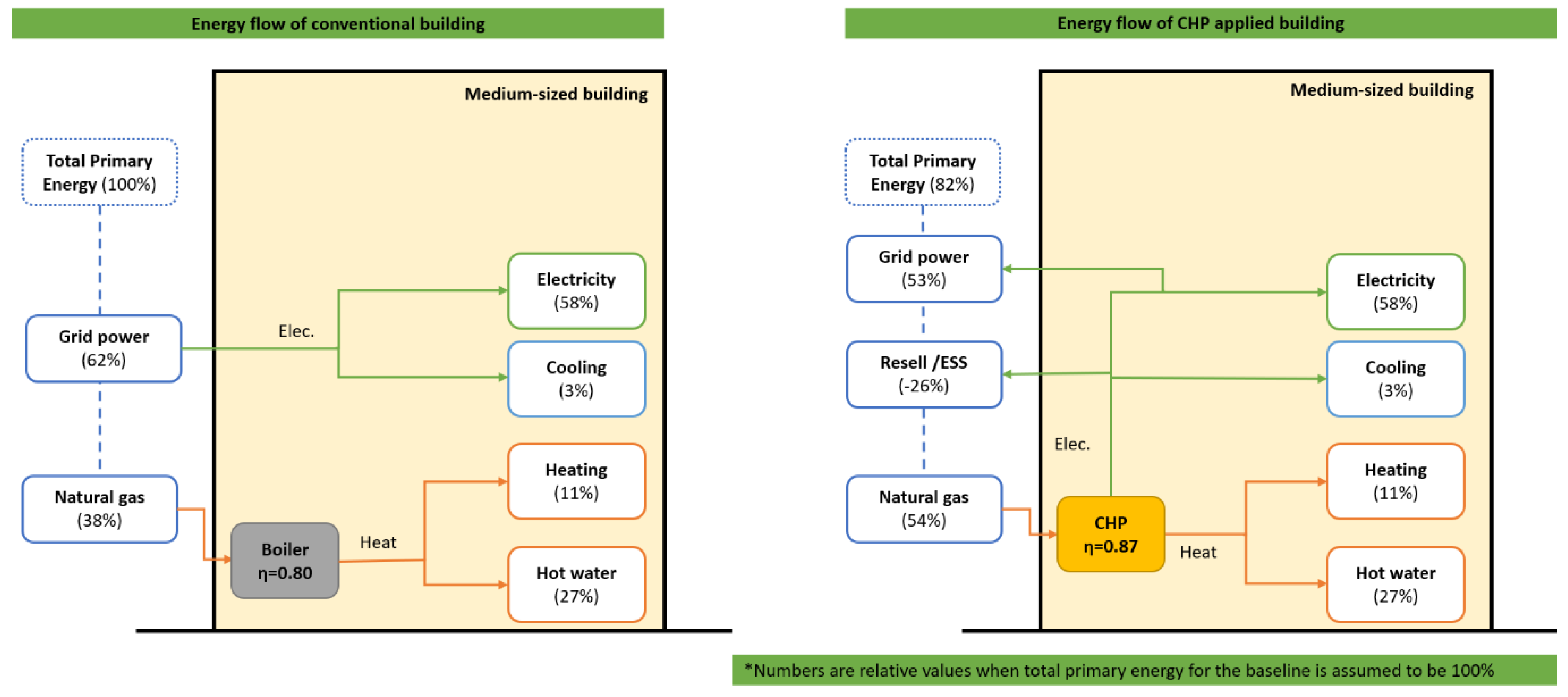
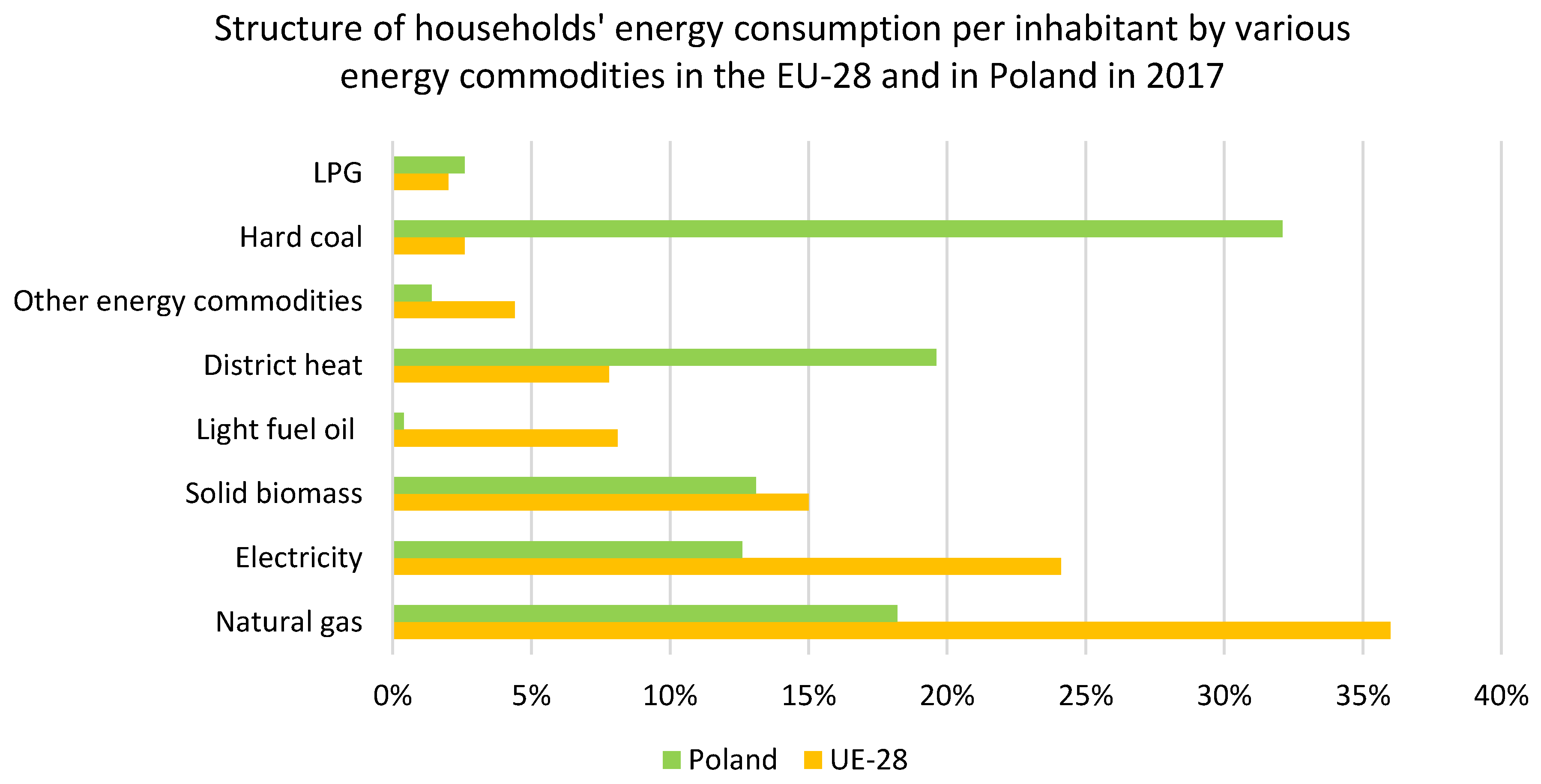
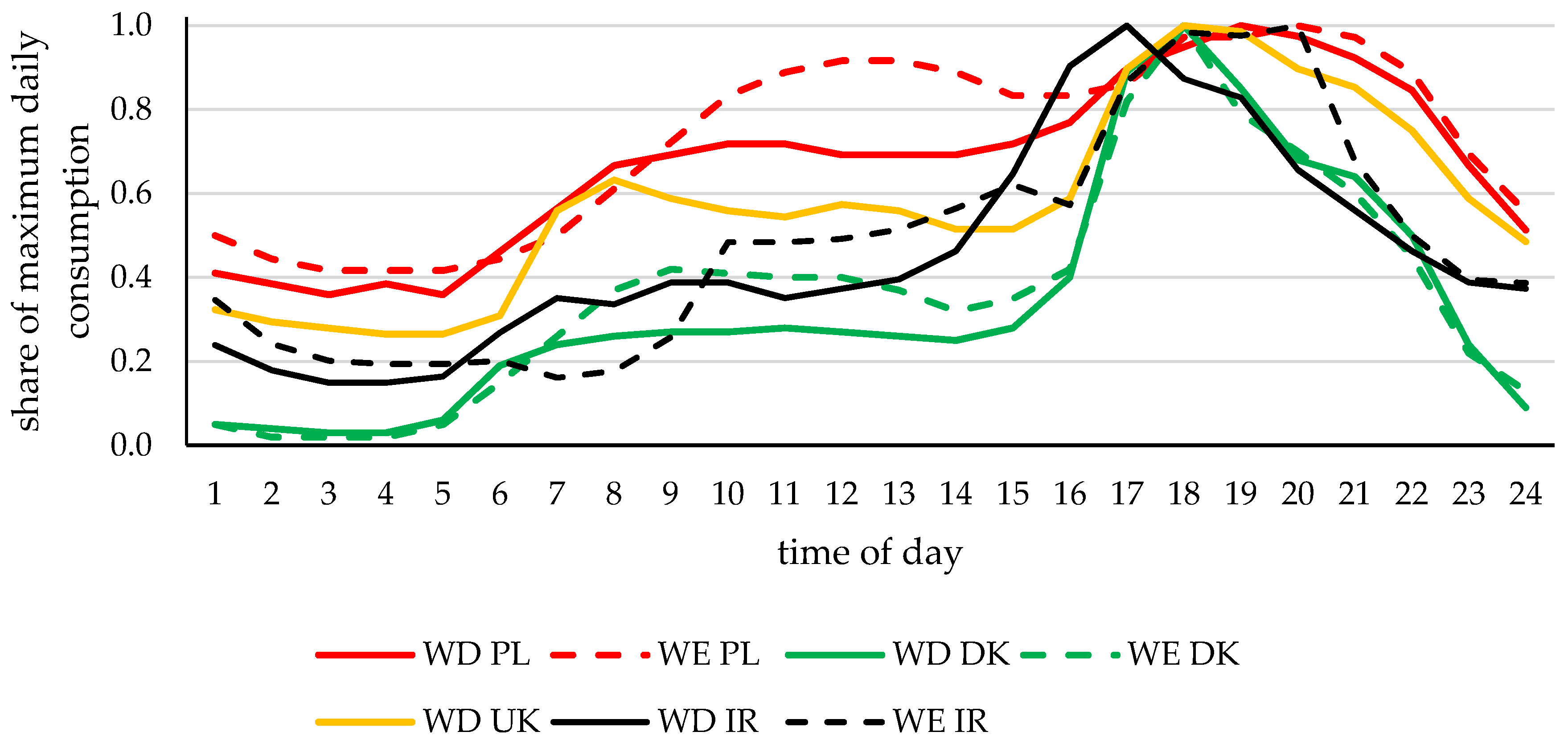

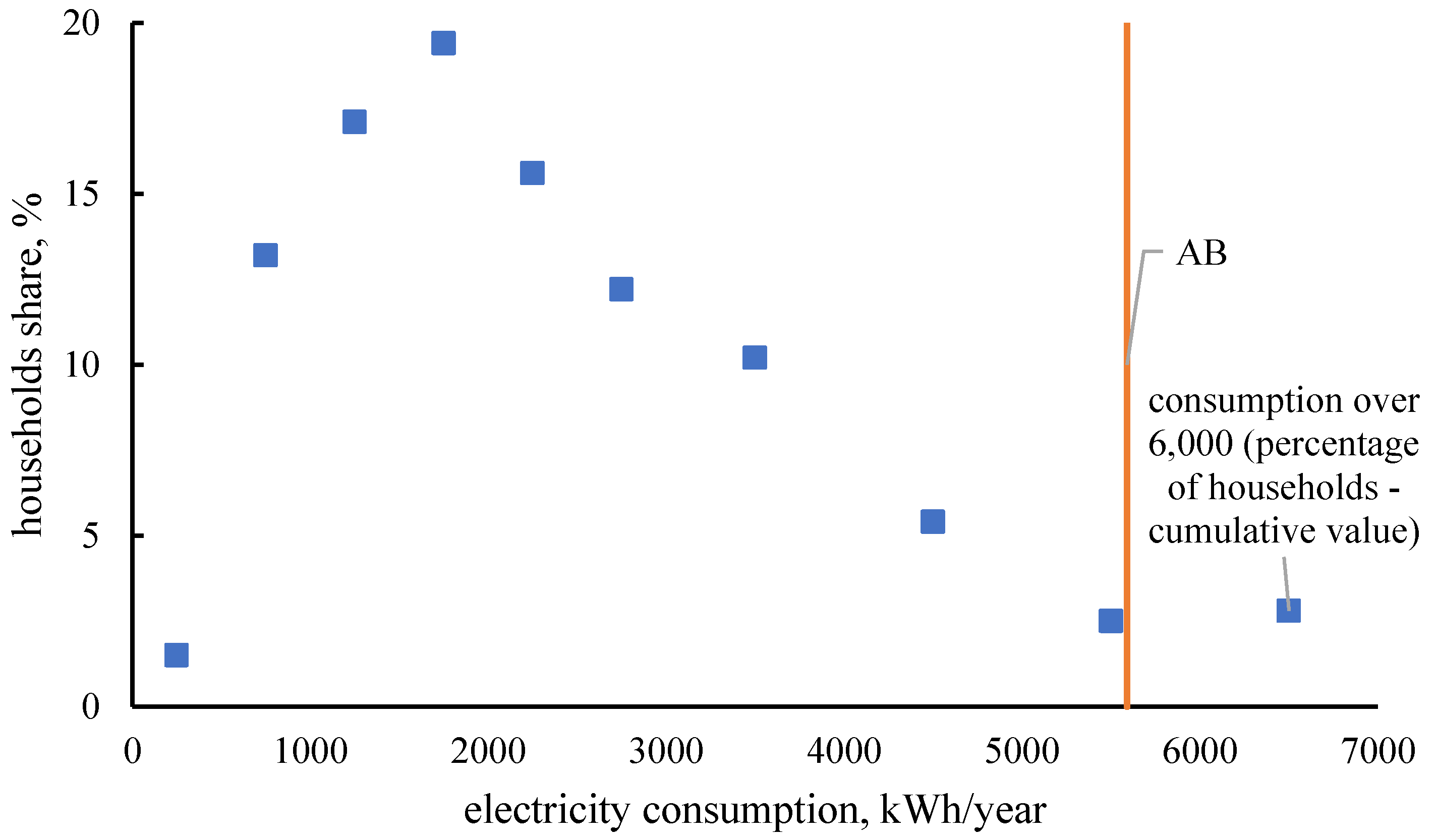
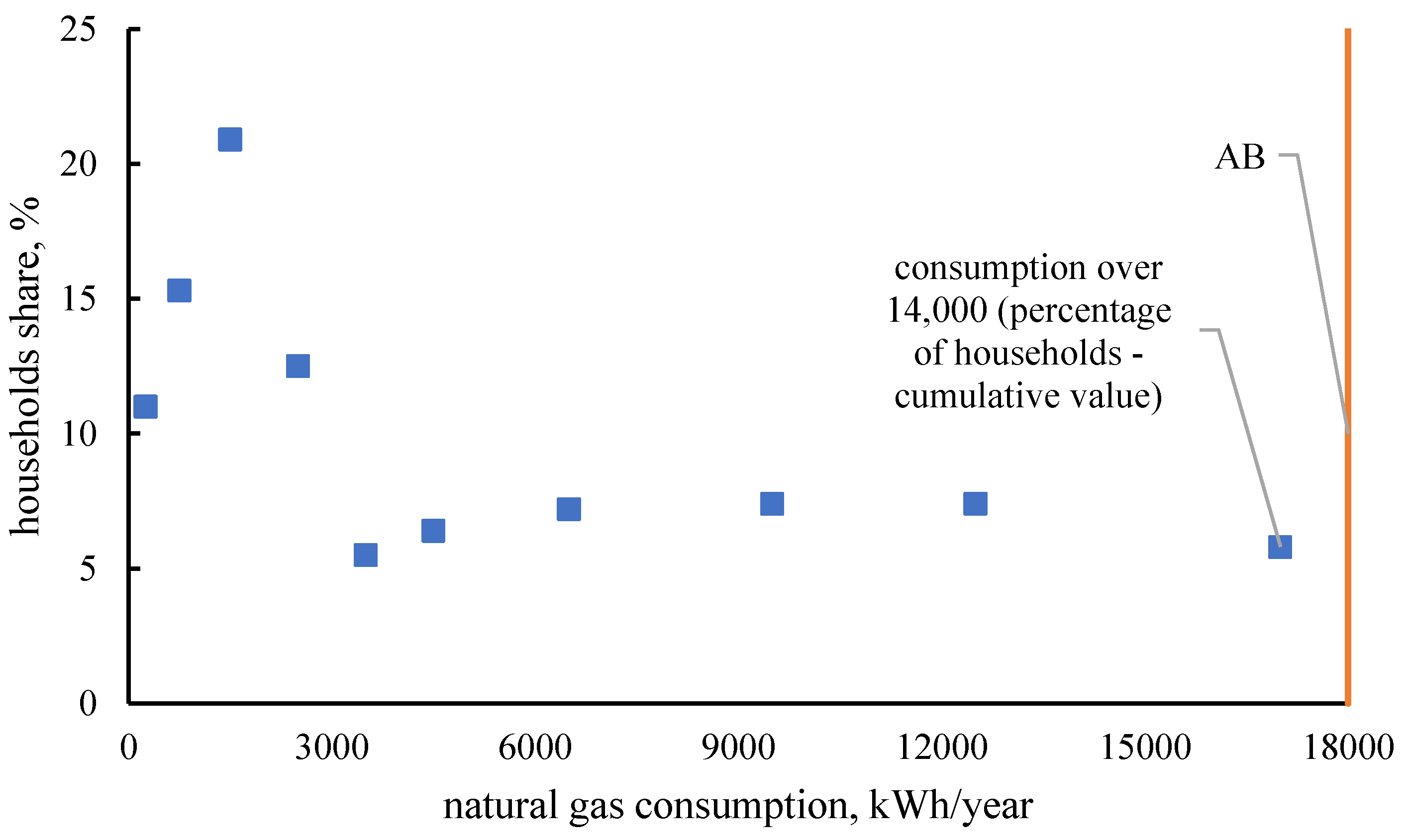
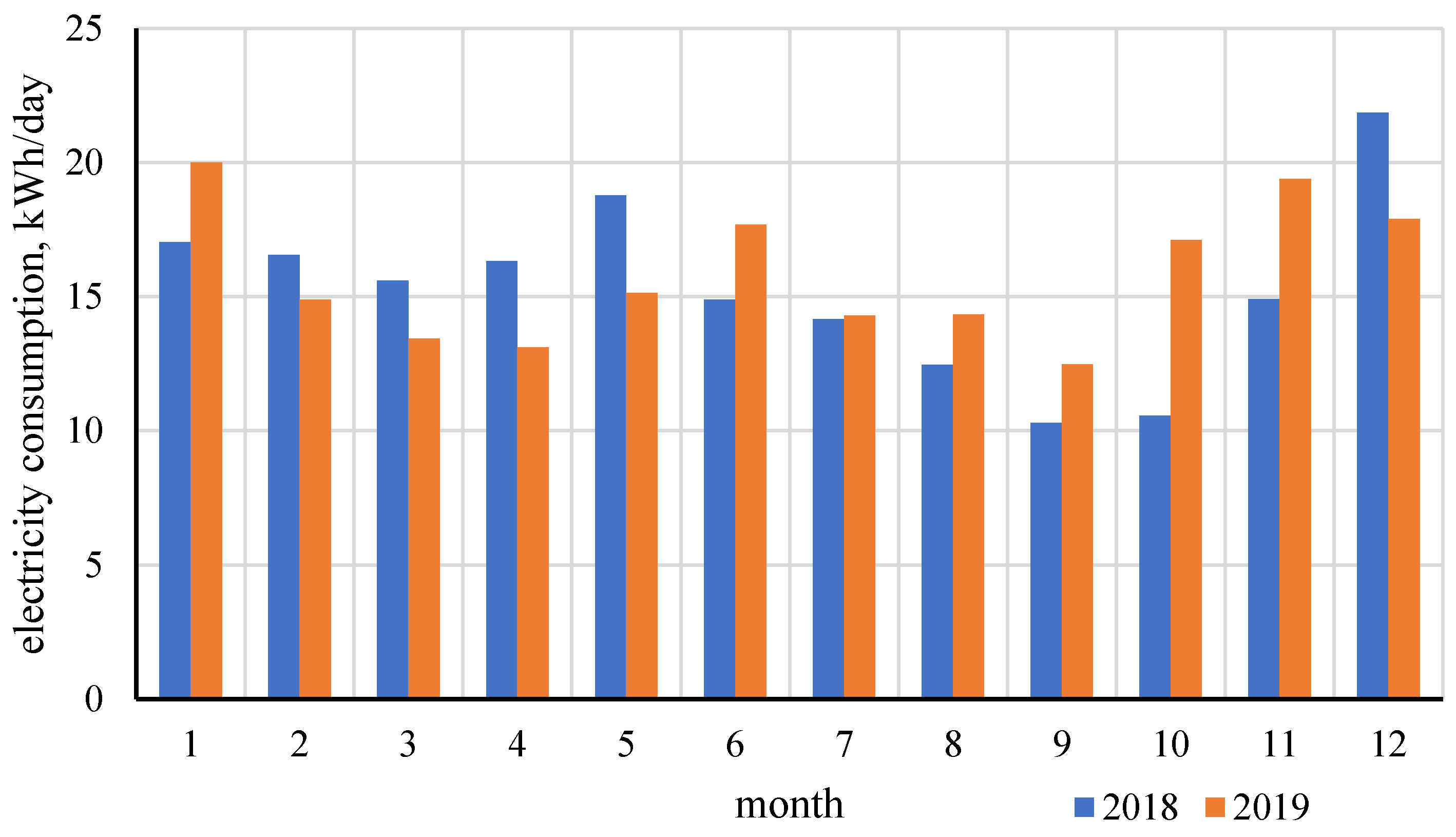
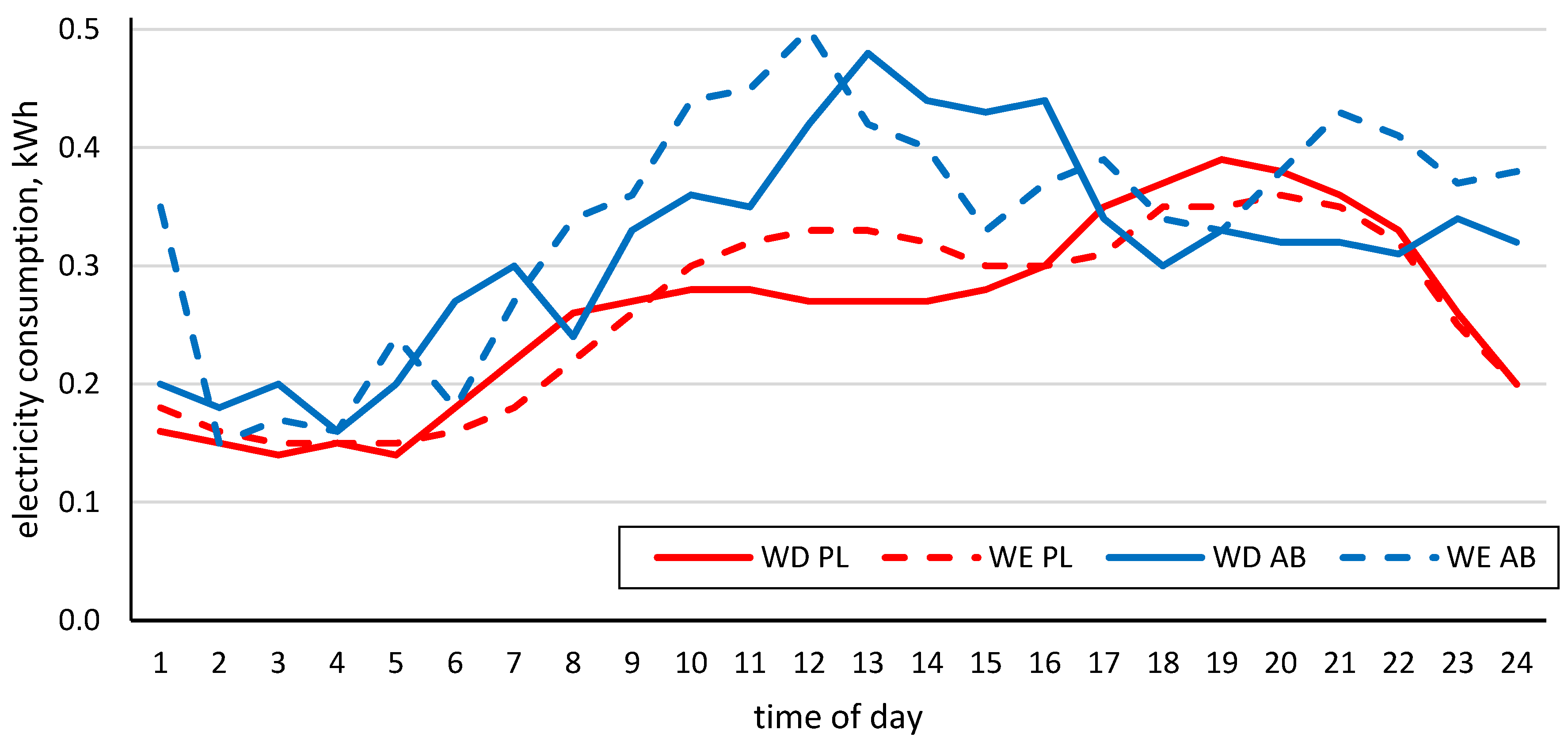
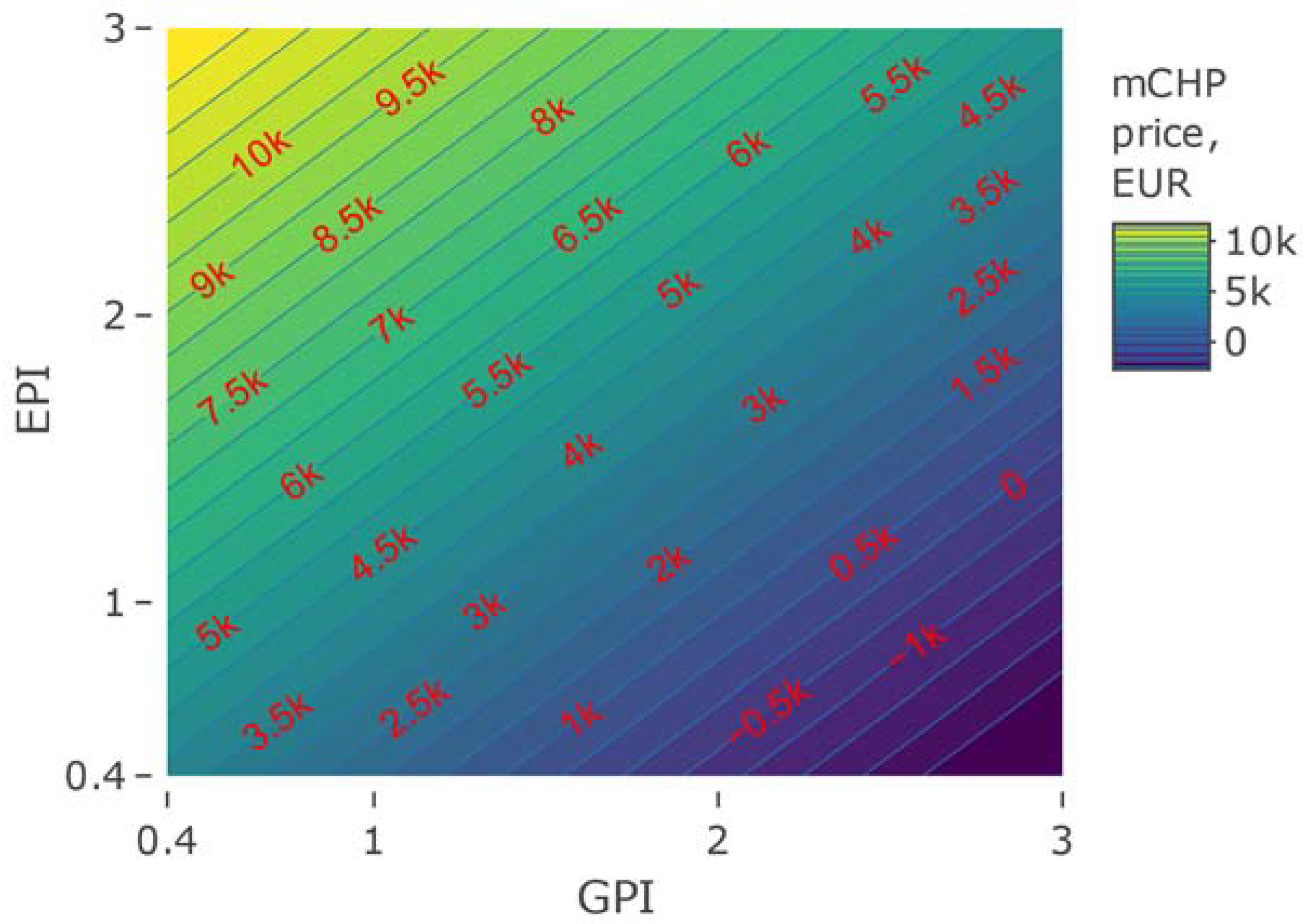
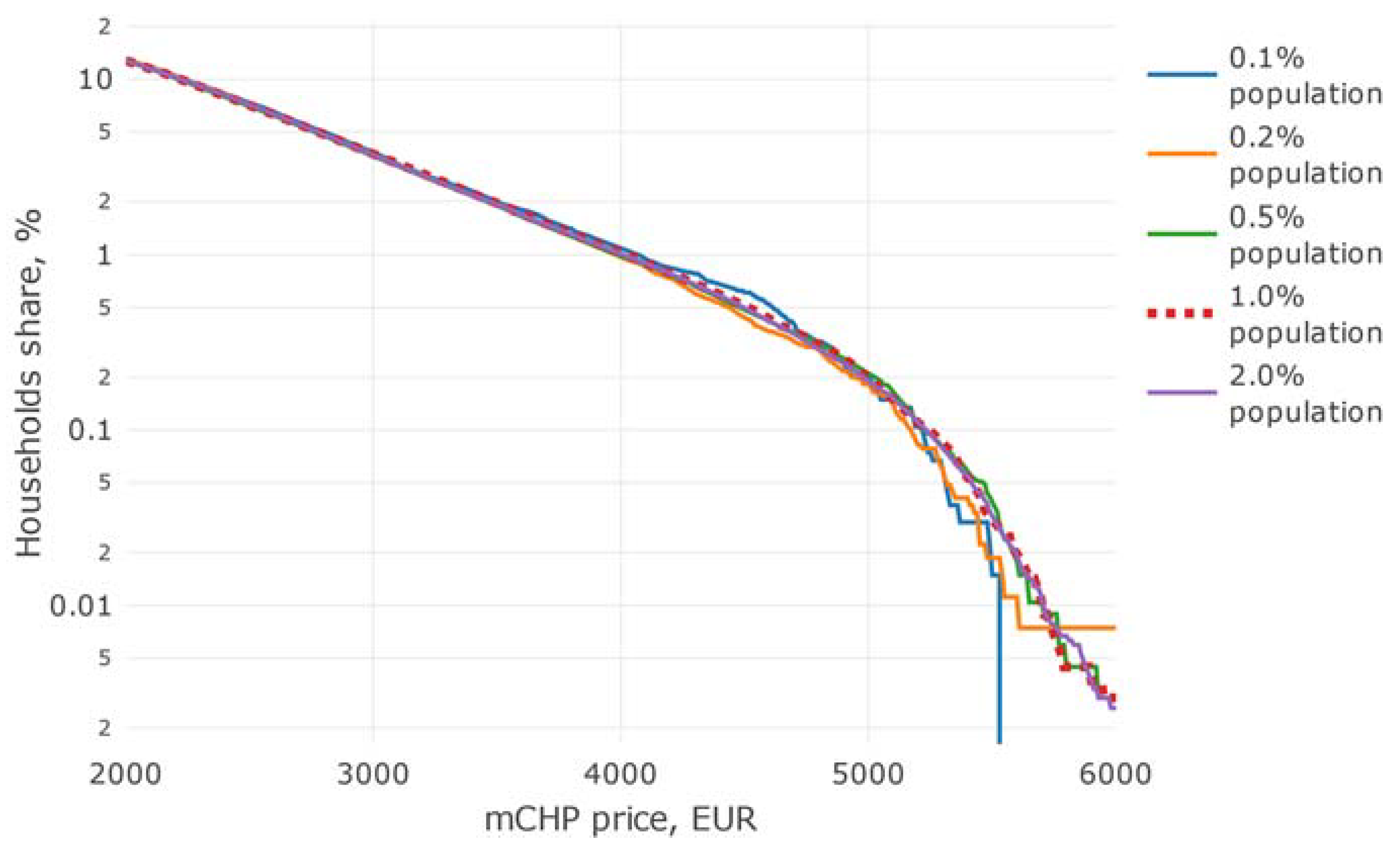
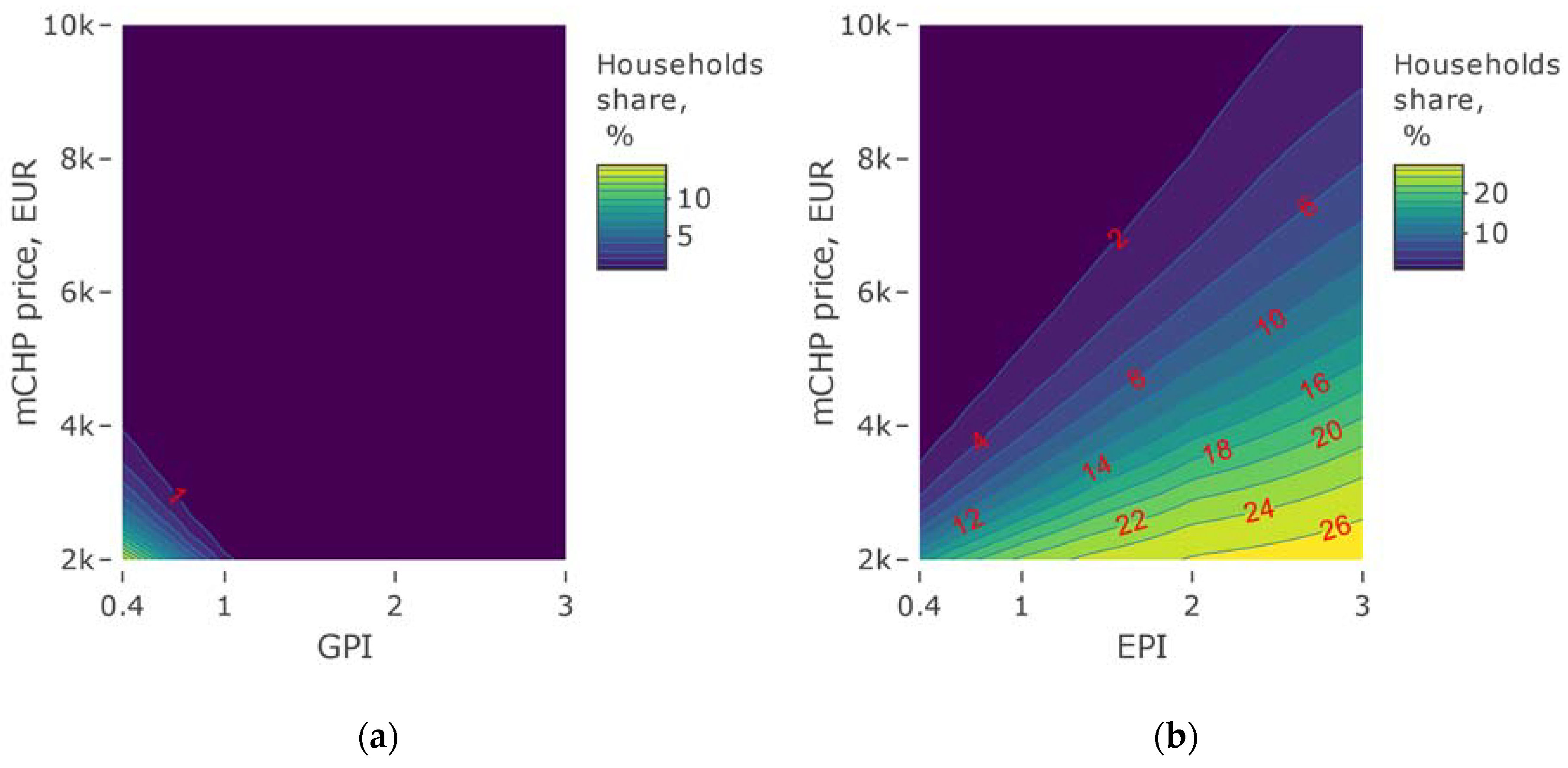
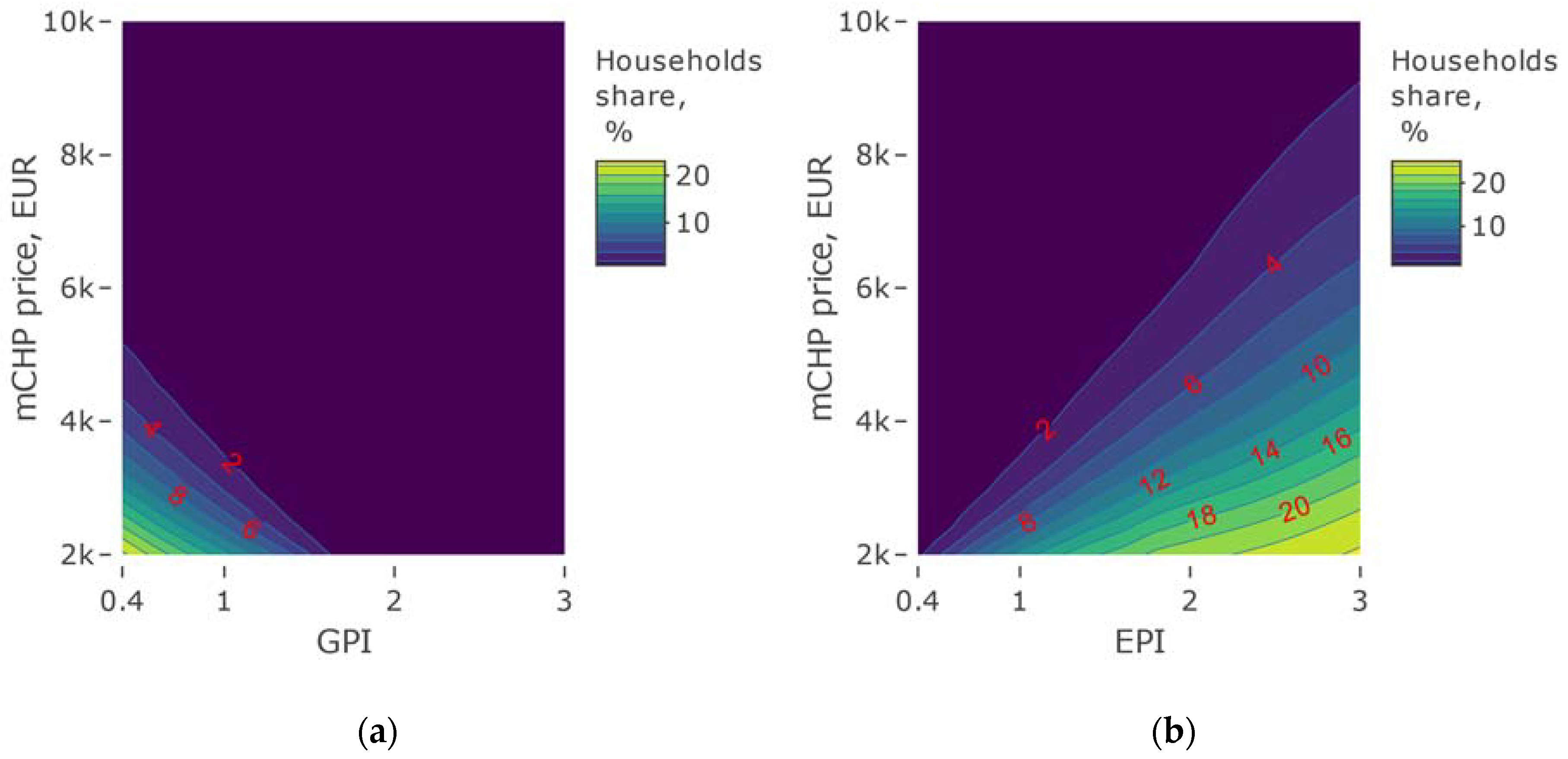
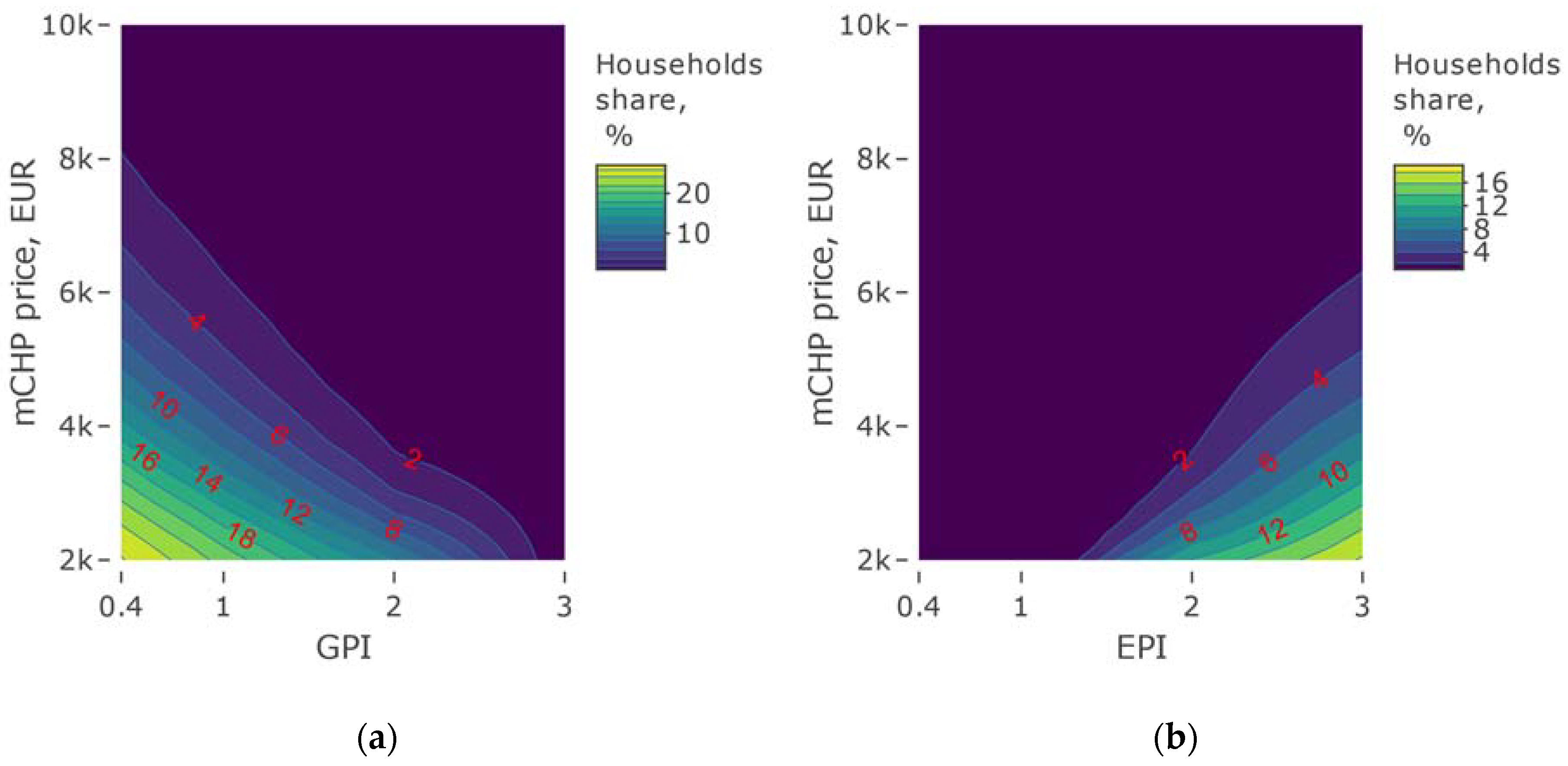
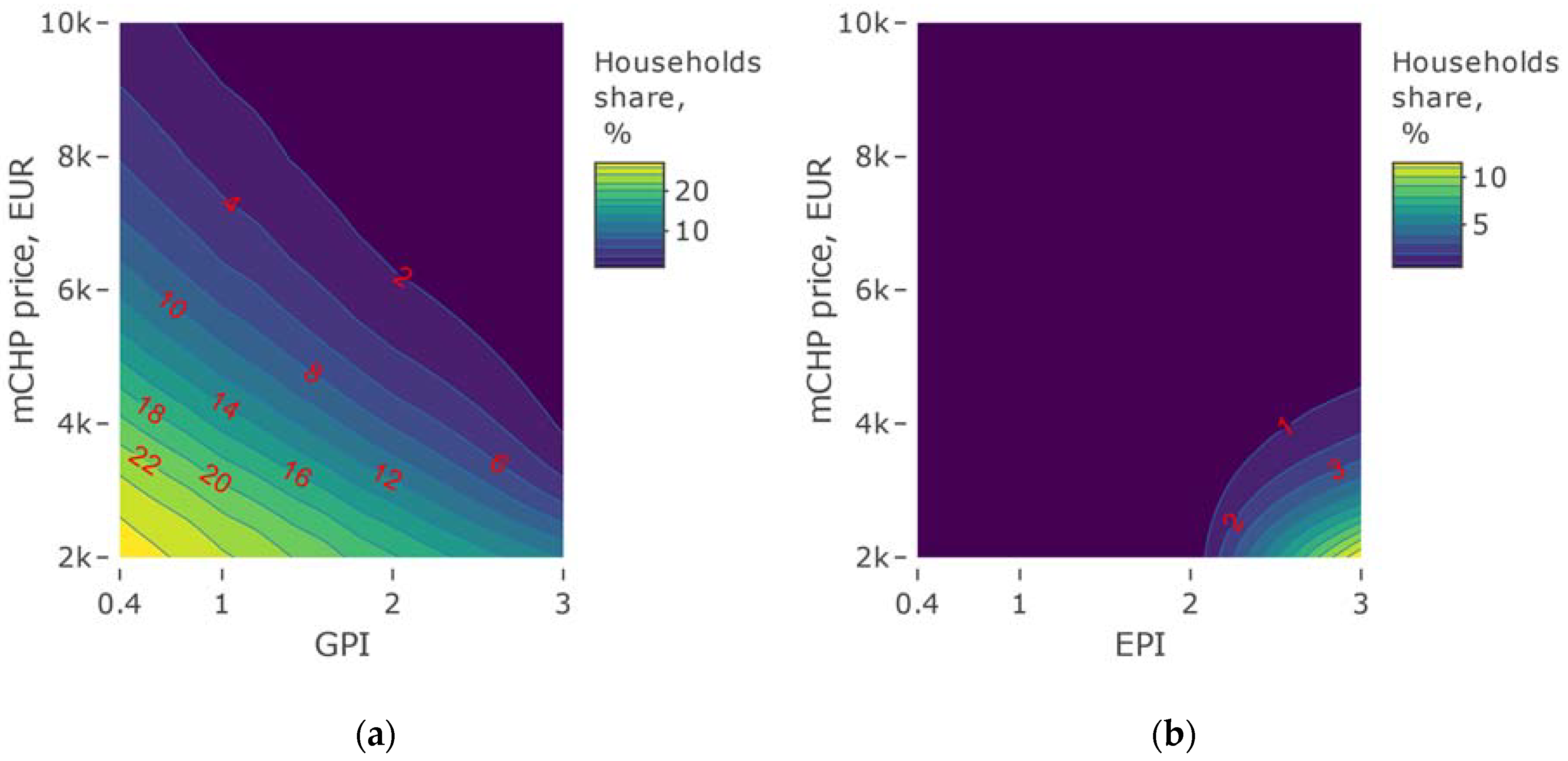
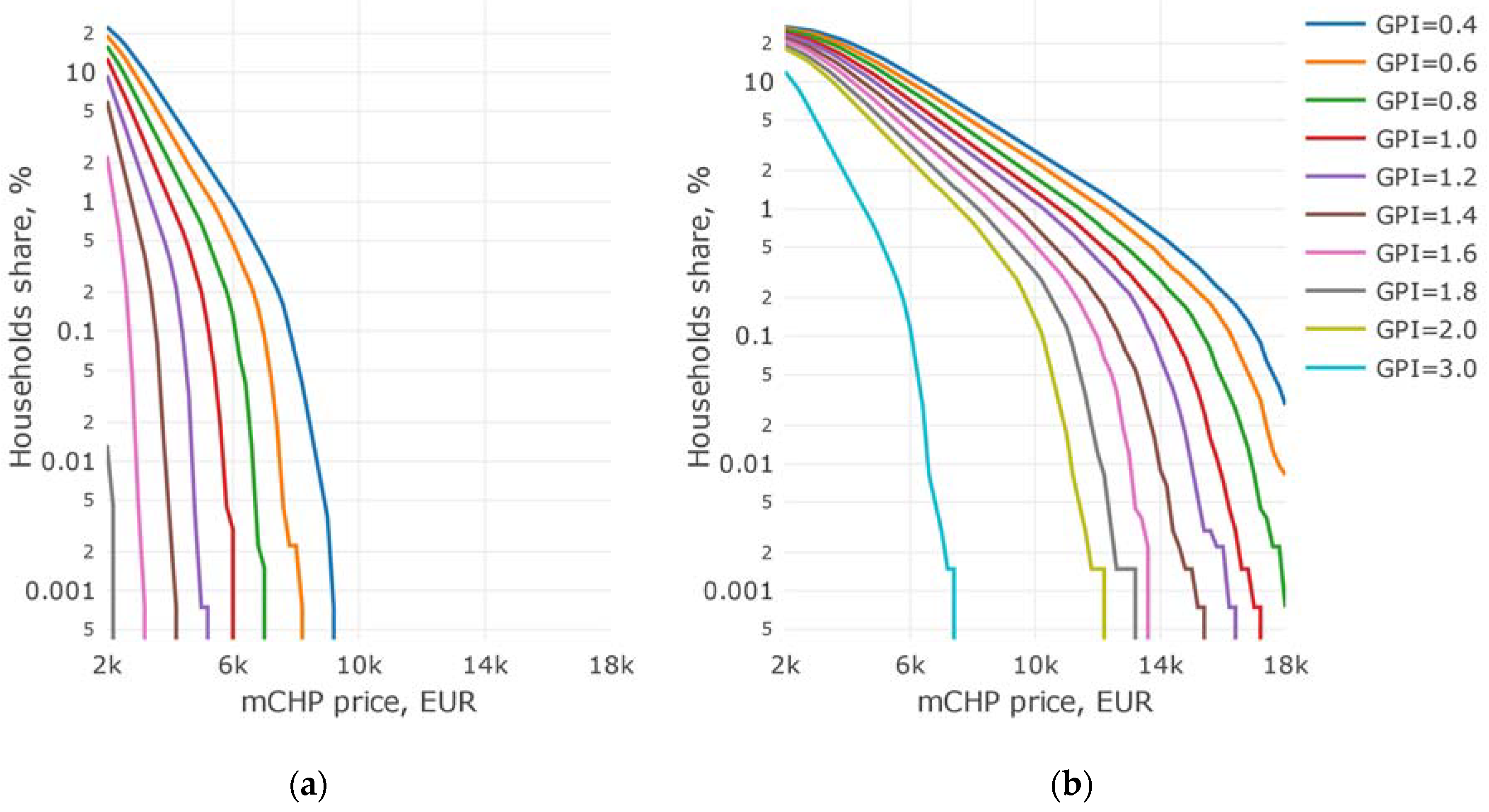


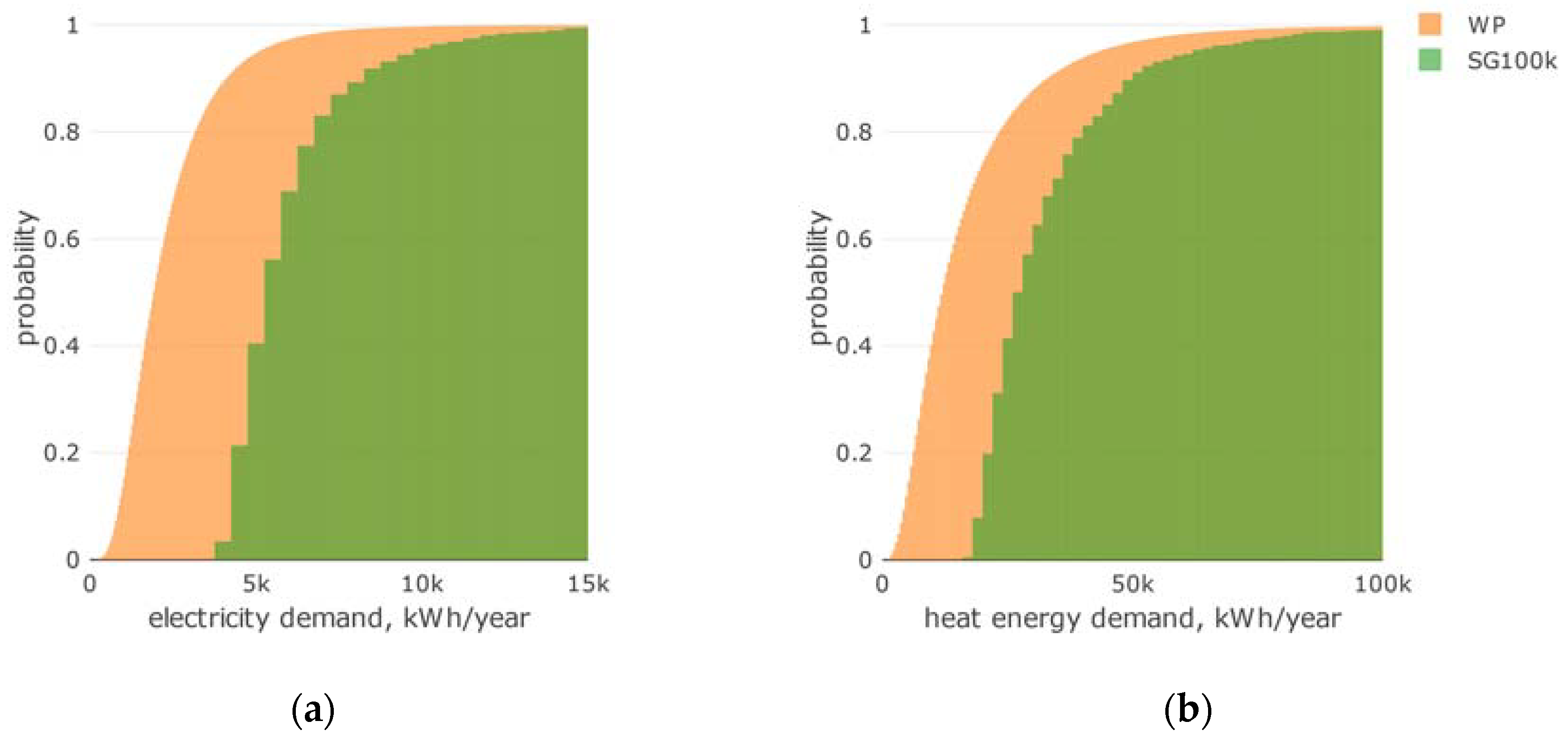
| Energy Commodity Households Group | Unit of Measure | Arithmetic Average | First Decile | First Quartile | Median | Third Quartile | Ninth Decile |
|---|---|---|---|---|---|---|---|
| Natural gas Household using gas for space heating | kWh/m2 | 123.55 | 29.33 | 50.00 | 112.03 | 174.60 | 285.71 |
| Natural gas Household using gas only for water heating and cooking | kWh/m2 | 38.11 | 9.38 | 17.64 | 33.55 | 50.13 | 92.86 |
| Natural gas Household using gas only for cooking | kWh/m2 | 25.13 | 7.20 | 10.97 | 19.74 | 30.77 | 48.30 |
| Voivodeship | Electricity Consumption, kWh/year | Share of People, % | |
|---|---|---|---|
| Average per Inhabitant | Average per Household | Access to Gas Network | |
| Lower Silesia | 758.1 | 1848.8 | 61.2 |
| Kuyavian–Pomeranian | 714.5 | 2038.7 | 42.9 |
| Lubelskie | 665.7 | 1810.5 | 40.7 |
| Lubuskie | 730.0 | 1986.6 | 51.9 |
| Łódzkie | 783.9 | 1913.8 | 39.6 |
| Lesser Poland | 790.0 | 2088.2 | 62.3 |
| Masowian | 859.7 | 2076.0 | 53.3 |
| Opolskie | 796.3 | 2011.2 | 41.9 |
| Podkarpackie | 571.4 | 1746.0 | 72.2 |
| Podlaskie | 754.3 | 1896.2 | 28.3 |
| Pomeranian | 744.9 | 1999.0 | 49.2 |
| Silesian | 778.2 | 1911.4 | 62.2 |
| Świętokrzyskie | 606.7 | 1646.4 | 36.8 |
| Warmian–Masurian | 701.1 | 2062.3 | 42.6 |
| Greater Poland | 764.3 | 2213.6 | 47.5 |
| West Pomeranian | 691.2 | 1824.0 | 59.1 |
| Voivodeship | Share of Number of People in Households, % | |||||||||
|---|---|---|---|---|---|---|---|---|---|---|
| 1 | 2 | 3 | 4 | 5 | 6 | 7 | 8 | 9 | 10 | |
| Lower Silesia | 25.9 | 27.9 | 20.8 | 15.1 | 5.8 | 2.5 | 1.3 | 0.40 | 0.15 | 0.04 |
| Kuyavian–Pomeranian | 22.1 | 25.9 | 21.2 | 16.9 | 7.9 | 3.4 | 1.8 | 0.54 | 0.21 | 0.06 |
| Lubelskie | 23.8 | 24.4 | 19.3 | 16.2 | 9.3 | 4.0 | 2.1 | 0.63 | 0.24 | 0.07 |
| Lubuskie | 22.6 | 26.8 | 21.6 | 16.7 | 7.0 | 3.0 | 1.6 | 0.48 | 0.18 | 0.05 |
| Łódzkie | 26.2 | 26.9 | 20.2 | 15.2 | 6.5 | 2.8 | 1.5 | 0.45 | 0.17 | 0.05 |
| Lesser Poland | 22.9 | 22.5 | 18.5 | 16.8 | 11.0 | 4.7 | 2.5 | 0.75 | 0.29 | 0.08 |
| Masowian | 27.3 | 26.0 | 19.2 | 15.3 | 6.9 | 3.0 | 1.6 | 0.47 | 0.18 | 0.05 |
| Opolskie | 22.7 | 26.2 | 20.2 | 16.3 | 8.3 | 3.6 | 1.9 | 0.57 | 0.22 | 0.06 |
| Podkarpackie | 19.4 | 21.4 | 18.6 | 17.7 | 13.0 | 5.6 | 3.0 | 0.89 | 0.34 | 0.09 |
| Podlaskie | 24.6 | 25.0 | 19.0 | 15.9 | 8.8 | 3.8 | 2.0 | 0.60 | 0.23 | 0.06 |
| Pomeranian | 23.4 | 26.2 | 20.7 | 16.6 | 7.4 | 3.2 | 1.7 | 0.51 | 0.20 | 0.05 |
| Silesian | 24.5 | 27.7 | 21.8 | 15.9 | 5.8 | 2.5 | 1.3 | 0.40 | 0.15 | 0.04 |
| Świętokrzyskie | 22.1 | 24.7 | 19.5 | 16.6 | 9.7 | 4.2 | 2.2 | 0.66 | 0.26 | 0.07 |
| Warmian–Masurian | 23.3 | 26.6 | 20.7 | 16.4 | 7.4 | 3.2 | 1.7 | 0.50 | 0.19 | 0.05 |
| Greater Poland | 20.5 | 23.2 | 20.6 | 18.3 | 9.9 | 4.2 | 2.3 | 0.67 | 0.26 | 0.07 |
| West Pomeranian | 24.6 | 27.9 | 21.4 | 15.5 | 6.0 | 2.6 | 1.4 | 0.41 | 0.16 | 0.04 |
| Area, m2 | Probability | ||
|---|---|---|---|
| from | to | flats | Single-Family House |
| 15 | 30 | 0.043 | 0 |
| 30 | 40 | 0.122 | |
| 40 | 50 | 0.181 | |
| 50 | 60 | 0.153 | 0.13 |
| 60 | 80 | 0.189 | |
| 80 | 100 | 0.089 | |
| 100 | 125 | 0.077 | 0.23 |
| 125 | 150 | 0.095 | 0.28 |
| 150 | 200 | 0.24 | |
| 200 | 300 | 0.028 | 0.09 |
| 300 | 500 | 0 | 0.03 |
| Parameters | Values, TWh | Error, % | |
|---|---|---|---|
| From Reference CSO [1] | Calculated From Generated Data by the Monte Carlo method | ||
| Electricity demand | 29.28 | 30.86 | 5.4 |
| Heating demand for heating | 188.24 | 181.71 | 3.5 |
| Heat demand for DHW heating | 38.48 | 37.81 | 1.8 |
© 2020 by the authors. Licensee MDPI, Basel, Switzerland. This article is an open access article distributed under the terms and conditions of the Creative Commons Attribution (CC BY) license (http://creativecommons.org/licenses/by/4.0/).
Share and Cite
Kryzia, D.; Kuta, M.; Matuszewska, D.; Olczak, P. Analysis of the Potential for Gas Micro-Cogeneration Development in Poland Using the Monte Carlo Method. Energies 2020, 13, 3140. https://doi.org/10.3390/en13123140
Kryzia D, Kuta M, Matuszewska D, Olczak P. Analysis of the Potential for Gas Micro-Cogeneration Development in Poland Using the Monte Carlo Method. Energies. 2020; 13(12):3140. https://doi.org/10.3390/en13123140
Chicago/Turabian StyleKryzia, Dominik, Marta Kuta, Dominika Matuszewska, and Piotr Olczak. 2020. "Analysis of the Potential for Gas Micro-Cogeneration Development in Poland Using the Monte Carlo Method" Energies 13, no. 12: 3140. https://doi.org/10.3390/en13123140
APA StyleKryzia, D., Kuta, M., Matuszewska, D., & Olczak, P. (2020). Analysis of the Potential for Gas Micro-Cogeneration Development in Poland Using the Monte Carlo Method. Energies, 13(12), 3140. https://doi.org/10.3390/en13123140







